Conquer the UCAT 2025: Top-Rated Prep Course for Outstanding Results
- Free Practice
- UCAT Overview
- Sample Questions
- Curriculum
- FAQs
The Universal Cognitive Aptitude Test (UCAT) measures candidates across 4 cognitive metrics. It is a specialized assessment built by Criteria Corp. to allow non-native English speakers to be judged based on the most important predictor of job performance, cognitive ability. This eliminates the biggest roadblock international candidates face during pre-employment tests, the verbal ability section, and its reliance on English.
Free Universal Cognitive Aptitude Practice Test
Practice UCAT for Free
No of Questions - 12
Time Limit - 3 Minutes

UCAT Prep Booster Course
Last Updated: Oct 24, 2025
Course Content
-
 Introduction 2 Steps - 20 MinutesBuy this Course: Get full access to all lessons, practice tests and guides.
Introduction 2 Steps - 20 MinutesBuy this Course: Get full access to all lessons, practice tests and guides. -
 Basic Math 4 Steps - 1 Hour 20 MinutesBuy this Course: Get full access to all lessons, practice tests and guides.
Basic Math 4 Steps - 1 Hour 20 MinutesBuy this Course: Get full access to all lessons, practice tests and guides. -
 Word Problems 4 Steps - 1 Hour 45 MinutesBuy this Course: Get full access to all lessons, practice tests and guides.
Word Problems 4 Steps - 1 Hour 45 MinutesBuy this Course: Get full access to all lessons, practice tests and guides. -
 Number Series 4 Steps - 1 Hour 30 MinutesBuy this Course: Get full access to all lessons, practice tests and guides.
Number Series 4 Steps - 1 Hour 30 MinutesBuy this Course: Get full access to all lessons, practice tests and guides. -
 Data Interpretation 4 Steps - 1 Hour 50 MinutesBuy this Course: Get full access to all lessons, practice tests and guides.
Data Interpretation 4 Steps - 1 Hour 50 MinutesBuy this Course: Get full access to all lessons, practice tests and guides. -
 Deductive Reasoning 4 Steps - 1 Hour 45 MinutesBuy this Course: Get full access to all lessons, practice tests and guides.
Deductive Reasoning 4 Steps - 1 Hour 45 MinutesBuy this Course: Get full access to all lessons, practice tests and guides. -
 Inductive Reasoning 4 Steps - 2 Hours 30 MinutesBuy this Course: Get full access to all lessons, practice tests and guides.
Inductive Reasoning 4 Steps - 2 Hours 30 MinutesBuy this Course: Get full access to all lessons, practice tests and guides. -
 Next In Series 4 Steps - 1 Hour 45 MinutesBuy this Course: Get full access to all lessons, practice tests and guides.
Next In Series 4 Steps - 1 Hour 45 MinutesBuy this Course: Get full access to all lessons, practice tests and guides. -
 Odd One Out 4 Steps - 2 Hours 10 MinutesBuy this Course: Get full access to all lessons, practice tests and guides.
Odd One Out 4 Steps - 2 Hours 10 MinutesBuy this Course: Get full access to all lessons, practice tests and guides. -
 Abstract Analogy 4 Steps - 1 Hour 45 MinutesBuy this Course: Get full access to all lessons, practice tests and guides.
Abstract Analogy 4 Steps - 1 Hour 45 MinutesBuy this Course: Get full access to all lessons, practice tests and guides. -
 Matrices 4 Steps - 2 Hours 05 MinutesBuy this Course: Get full access to all lessons, practice tests and guides.
Matrices 4 Steps - 2 Hours 05 MinutesBuy this Course: Get full access to all lessons, practice tests and guides. -
 Attention to Detail 10 Steps - 3 Hour 35 MinutesBuy this Course: Get full access to all lessons, practice tests and guides.
Attention to Detail 10 Steps - 3 Hour 35 MinutesBuy this Course: Get full access to all lessons, practice tests and guides.- Error Checking - Written Guide
- Error Checking Practice Questions – A
- Error Checking Practice Questions – B
- Error Checking Practice Questions – C
- Error Checking Practice Questions – D
- Error Checking Practice Questions – E
- Error Checking Practice Questions – F
- Error Checking Practice Questions – G
- Error Checking Practice Questions – H
- Error Checking Practice Questions – I
-
 Practice Questions - Untimed 1 StepBuy this Course: Get full access to all lessons, practice tests and guides.
Practice Questions - Untimed 1 StepBuy this Course: Get full access to all lessons, practice tests and guides. -
 Practice Questions - Timed 1 StepBuy this Course: Get full access to all lessons, practice tests and guides.
Practice Questions - Timed 1 StepBuy this Course: Get full access to all lessons, practice tests and guides.
Success Stories
4.6 126 Reviews
rob, 16 Jan
Solid review course that covers the…
Solid review course that covers the relevant topics in good detail
chad, 11 Jan
Great Program, amazing practice simulations
Easy to understand. Passed tests on first time thru.
QUEEN RIGHTEOUS, 07 Jan
Highly recommended.Great instructional…
Highly recommended.Great instructional information. I passed on the first try.
MasterCommand, 14 Nov
Prepterminal. Prepare, practice, execute.
To say that Prepterminal helped me prepare and be ready for the testing phase would be an understatement. At first, looking at the course, I felt overwhelmed with the course material, but the course broke down each subject effectively which made it easier to understand. There were a few issues with some of the audio portion of the testing course, but beyond that, the course was well worth the money.
Abazix LLC, 09 Nov
Would recommend
Study material helped to pass my test on the first try.
Natalia M. Delgado, 08 Nov
Exelent course 100% guaranteed
Exelent course 100% guaranteed
What is Unique in Criteria UCAT?
What sets the Universal Cognitive Aptitude Test (UCAT) apart is its minimal emphasis on verbal skills, making it an ideal choice for non-native English speakers. Unlike the Criteria Cognitive Aptitude Test (CCAT), which heavily values verbal aspects, the UCAT focuses purely on cognitive abilities.
Developed by Criteria Corp. in 2016, the UCAT is a cutting-edge, language-independent assessment. It complements other popular tests from Criteria Corp., such as the CCAT and the Employee Personality Profile (EPP). Criteria Corp. emphasizes cognitive ability as the best predictor of job performance, a focus that underpins their suite of assessments.
Despite the key difference in verbal emphasis, both the UCAT and CCAT are highly correlated, evaluating similar cognitive skills and abilities. These are the cognitive areas assessed by the UCAT:
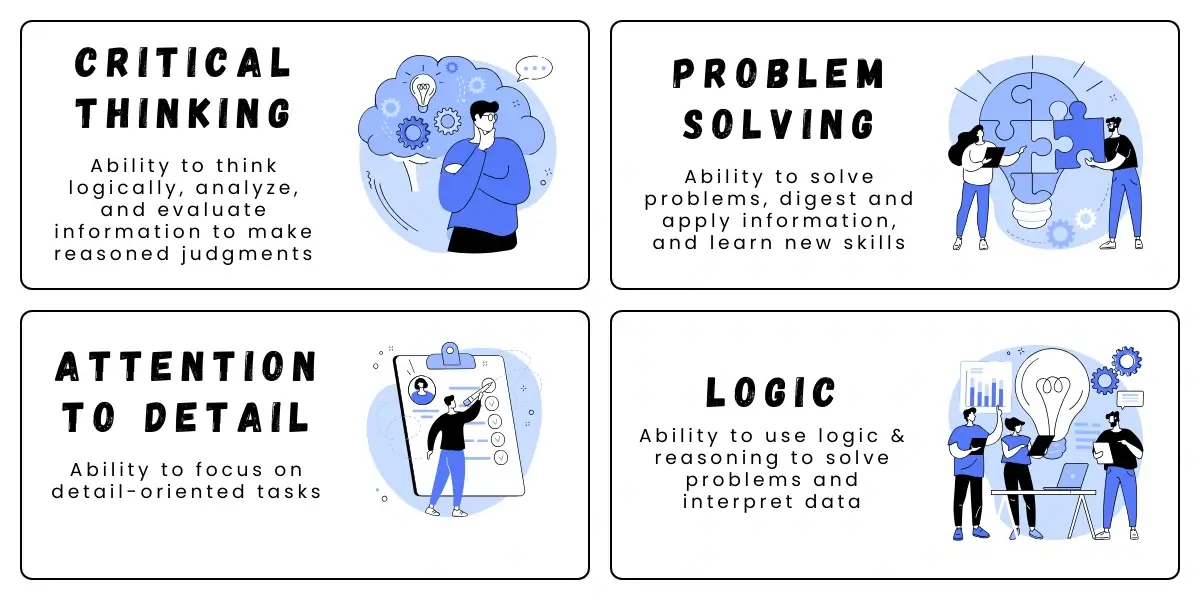
Your performance in these sections reveals your general cognitive aptitude to employers, regardless of the language you speak. This aptitude encompasses your learning speed, problem-solving ability, pattern recognition, capacity to digest and apply new information, and critical thinking skills. These abilities are universally applicable, ensuring that your cognitive strengths are recognized no matter your linguistic background.
Quick Facts about UCAT
- Language Independent: Ensures fair assessment for non-native English speakers.
- Suitable for Roles Without Strong Communication Requirements: Ideal for technical, analytical, or specialized positions.
- Quick 20-Minute Duration: Minimizes disruption and reduces test fatigue.
- No Calculators Allowed: Assesses true mental agility and problem-solving skills.
- Instant Results: Provides immediate feedback for rapid decision-making.
- Designed for Mid to High-Level Positions: Targets roles requiring advanced cognitive abilities.
- Assesses Cognitive Ability Across Four Categories: Ensures a comprehensive evaluation of various cognitive skills.
- Available in 20 Languages: Increases accessibility for a global candidate pool.

*Note: Our UCAT Prep Course Is Designed & Presented in English
Who is the Universal Cognitive Aptitude Test for?
The UCAT is a great tool for testing quantitative and analytical positions. In fact, Criteria Corp recommends using it for any mid-to-high-level positions that typically require a college degree. This makes it ideal for roles like:




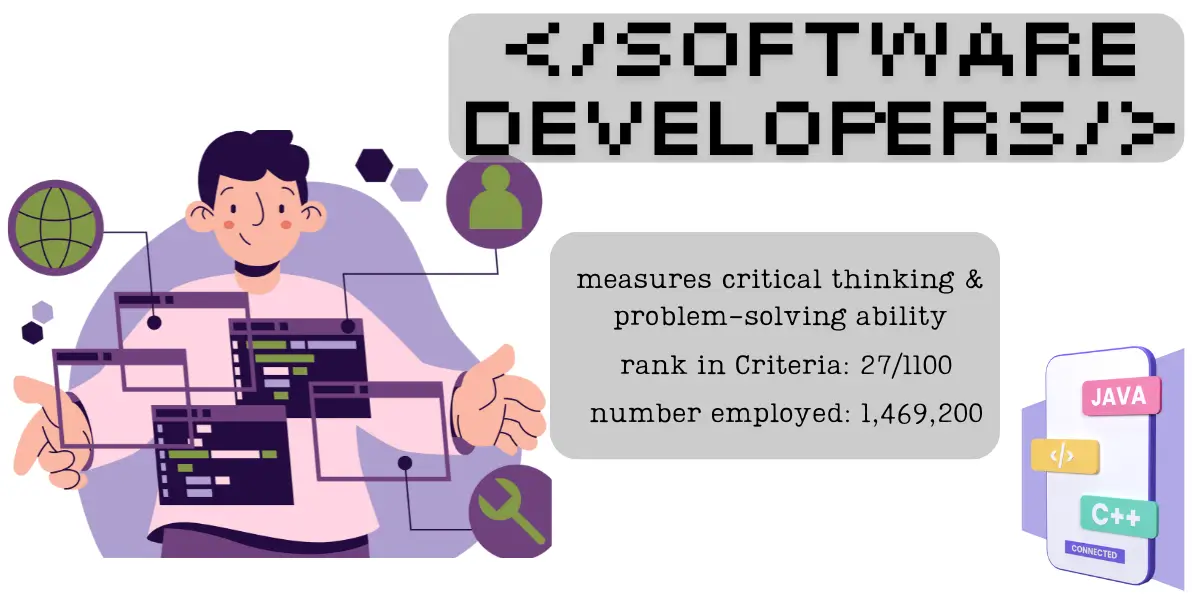
UCAT Test Format
The UCAT’s unique focus on measuring general intelligence through a non-verbal lens is reflected in its test format. You are presented with 40 questions ranging from four key sections, these are:
Numerical Reasoning
Basic Math
Word Problems
Number Series
Data Interpretation
Spatial (Abstract) Reasoning
Next in Series
Odd One Out
Abstract Analogy
Matrices
Logical Reasoning
Deductive
Inductive
Attention to Detail
Error Checking
Character Comparison
You must have noticed that there is no language section included. But don’t let this fool you. This doesn’t mean you will have an easy time solving the UCAT. In fact, time is one of the biggest obstacles in your way. With only 20 minutes to solve 40 items, you have a mere 30 seconds per question, demanding both accuracy and swiftness.
These multiple-choice questions mostly gives you five answer options, containing a mix of text-based, visual, and graphical/tabular items. This huge question variety can be disorienting on the test day if it is your first time dealing with them. Doubly so under the strict time constraints of the assessment, which leaves little room for doubt.
To help you on your learning journey, here are some samples from our UCAT Prep course.
Abstract Analogy Sample Question
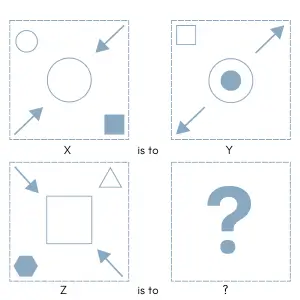
-
A:
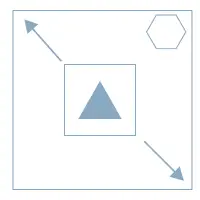
-
B:
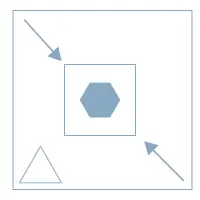
-
C:

-
D:
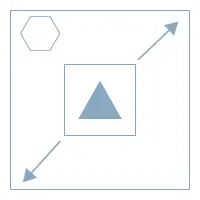
-
E:
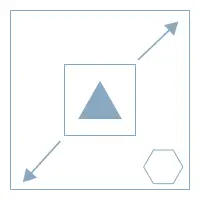
Explanation:
Observe
Start by closely observing the transformations in the first set of images. Notice that the middle shape remains fixed in place, while the other elements undergo various changes. The arrows initially pointing towards the middle circle flip to point in opposite directions. Additionally, the unshaded circle located at the top left of the image moves inside the middle circle, and the shaded square situated at the bottom right flips and relocates to the top left of the screen.
Isolate
Having identified multiple transformations, isolate each of them for a clearer understanding. Notably, the shaded shape inverts to take the place of the unshaded shape, the unshaded shape shifts positions within the middle shape and changes to a shaded form, the arrows change direction from their initial orientation, while the middle shape remains static throughout these transitions.
Compare
To ensure the consistency of these transformations, compare the third image in the sequence with the first image. According to our observations, the arrows in the third image should point outward, the shaded hexagon should flip to the top right, losing its color in the process, and the unshaded triangle located at the top right would move inside the unchanging middle square and become shaded.
Apply
Now that we've isolated and confirmed the transformations, apply these rules to the third image. Following this systematic approach, it becomes evident that Option A is the only one that adheres to all the necessary requirements.
Deductive Reasoning Sample Question
Samantha entered the conference room expecting it to be ready for the upcoming meeting. However, she found the room in disarray with chairs scattered and papers strewn everywhere. After asking around, she gathered the following information about the team members who were last in the room:
- Alex always ensures the room is tidy before leaving, as he values organization highly.
- Jordan has a reputation for being meticulous but has been under a lot of stress lately and might have been distracted.
- Morgan enjoys organizing events and often leaves rooms in a better state than she found them.
- Taylor is generally responsible but was seen leaving the room hurriedly just before Samantha arrived.
-
A:
Alex
-
B:
Jordan
-
C:
Taylor
-
D:
Morgan
Explanation:
Alex’s high value on organization and Morgan’s tendency to leave rooms better than she found them make them unlikely culprits. Jordan, despite being meticulous, might have been distracted due to stress, but this does not directly correlate with leaving a mess. Taylor, on the other hand, was seen leaving the room hurriedly just before Samantha arrived, which could indicate a rushed and careless departure, making Taylor the most likely responsible for the mess based on the provided information.
Inductive Reasoning Sample Question
Statement: "Learning new sports can enhance physical abilities."
Argument: "People who learn to play Volleyball exhibit improved running speeds and jumping ability."
-
A:
Yes, the argument is valid.
-
B:
No, the argument is not valid.
Explanation:
The argument validates the statement by showing that learning a new skill, such as playing a musical instrument, is associated with improved cognitive functions, including memory and concentration. This supports the claim that learning new skills is beneficial for cognitive enhancement.
Data Interpretation Sample Question
A company's annual report includes a pie chart detailing the proportion of total expenses allocated to various departments: Research and Development (R&D), Marketing, Human Resources (HR), and Operations. The chart also correlates department expenses with company revenue, indicating efficiency ratios.
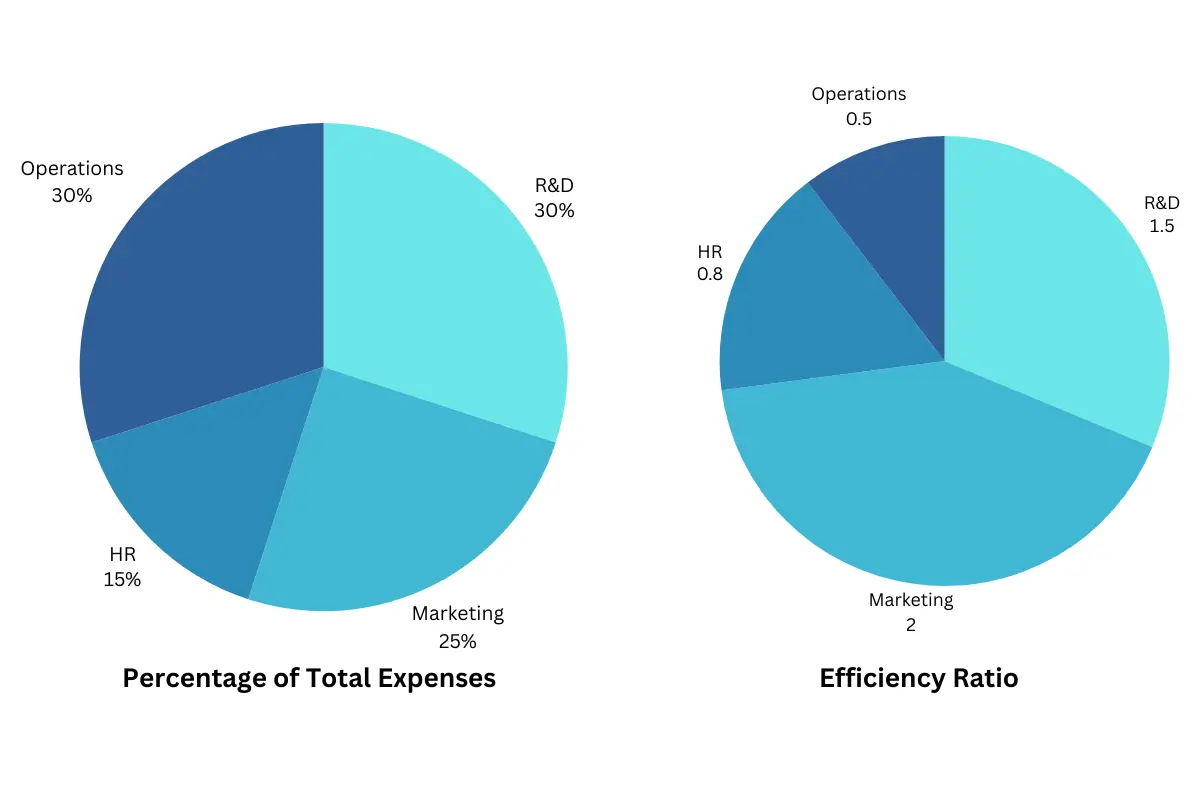
-
A:
R&D
-
B:
Marketing
-
C:
HR
-
D:
Operations
-
E:
Both R&D and Operations
Explanation:
To solve the question we need to calculate the potential increase in revenue for each department if their budget was increased by 5%.
Let’s assume the total annual expenses are $X. Then, the expenses for each department are as follows:
R&D: 0.30X
Marketing: 0.25X
HR: 0.15X
Operations: 0.30X
If each department receives a 5% increase in their budget, the new expenses will be:
R&D: 0.30X * 1.05 = 0.315X
Marketing: 0.25X * 1.05 = 0.2625X
HR: 0.15X * 1.05 = 0.1575X
Operations: 0.30X * 1.05 = 0.315X
The revenue generated by each department is the product of its expenses and its efficiency ratio. So, the new revenues will be:
R&D: 0.315X * 1.5 = 0.4725X
Marketing: 0.2625X * 2 = 0.525X
HR: 0.1575X * 0.8 = 0.126X
Operations: 0.315X * 0.5 = 0.1575X
The department that generates the highest increase in revenue with a 5% increase in budget is the one with the highest new revenue. From the calculations above, we can see that the Marketing department would generate the highest revenue of 0.525X with a 5% increase in its budget. Therefore, if the company wants to maximize revenue, the Marketing department should receive the 5% increase in budget.
*Note: These are provided to give you an idea of how the questions are presented. The actual exam contains much harder questions.
Scoring Guide for the UCAT
Once a candidate finishes the Universal Cognitive Aptitude Assessment, the employer gets the results instantly. Four key metrics stand out on the score report, these are:
- Raw Score: This is the number of questions answered correctly out of 40. For example, a raw score of 30 means you scored 30 answers correctly out of 40.
- Percentile: This ranking showcases how you performed compared to other test takers. For example, a score of 50 means you scored better than 50% of the original norm group.
Note: A norm group means the initial pool of candidates based on whose performance the test was standardized.
- Sub-Scores: Indicates your respective score in each of the different domains, such as Logic & Analysis, Numerical Reasoning, Attention to Detail, and Spatial Reasoning.
- Score Ranges: This is the recommended score for each job profile according to Criteria Corp. Once your performance is calculated with respect to the above metrics, the score report tallies how you performed in reference to each of these score ranges and whether you are “In Range” for the job role.
Here are some sample score ranges according to Criteria:
| Profile | Score Range |
|---|
| Accounting | 16 – 40 |
| Analyst | 18 – 40 |
| Architecture and Drafting | 16 – 40 |
| Art and Design | 15 – 40 |
| Aviation | 16 – 40 |
| Business Operations Specialist | 16 – 40 |
| Cashier | 12 – 40 |
| Collections | 15 – 40 |
| Counselling and Social Work | 16 – 40 |
| Customer Service Representative | 13 – 40 |
| Data Analytics and Statistics | 20 – 40 |
| Dispatcher | 14 – 40 |
| Driver | 11 – 40 |
| Education | 16 – 40 |
| Emergency and Protective | 15 – 40 |
| Engineering | 18 – 40 |
| Farming, Agriculture and Forestry | 14 – 40 |
| Finance Manager | 18 – 40 |
| Financial Services | 16 – 40 |
| Food Preparation and Service | 11 – 40 |
| Freight and Distribution | 11 – 40 |
| Front Line Supervision | 15 – 40 |
| Grounds and Cleaning | 12 – 40 |
| HR Manager | 17 – 40 |
| Human Resources | 16 – 40 |
| IT and Computing Systems | 17 – 40 |
| IT Support | 16 – 40 |
| Journalism and Communications | 16 – 40 |
| Legal | 20 – 40 |
| Machinist / Manufacturing | 12 – 40 |
| Management | 16 – 40 |
| Marketing and Product | 17 – 40 |
| Media Production | 16 – 40 |
| Medical Assistance | 15 – 40 |
| Medicine and Healthcare | 18 – 40 |
| Mining, Oil, and Gas Worker | 12 – 40 |
| Nursing | 17 – 40 |
| Office and Administrative Support | 15 – 40 |
| Paralegal and Legal Support | 15 – 40 |
| Personal Care and Services | 13 – 40 |
| Plant Operator | 14 – 40 |
| Production Manager / Supervisor | 15 – 40 |
| Production Worker | 10 – 40 |
| Project Manager | 17 – 40 |
| Retail Sales | 13 – 40 |
| Sales / Account Executive | 15 – 40 |
| Sales Manager | 16 – 40 |
| Sales Representative | 13 – 40 |
| Science and Research | 18 – 40 |
| Senior and Executive Leadership | 18 – 40 |
| Service Technician | 13 – 40 |
| Software Development | 16 – 40 |
| Store Manager | 14 – 40 |
| Trades and Construction | 14 – 40 |
Why Choose Our Criteria UCAT Prep Course?
Mastering the Criteria UCAT’s distinct question types and unique format requires targeted preparation. Our course provides:

Comprehensive UCAT Lessons: Gain a deep understanding of the UCAT’s structure and components, along with strategic insights to tackle each section effectively.

Proven Test-Taking Techniques: Learn time-tested strategies to navigate the UCAT, avoid common traps, and handle even the most challenging questions with confidence.

Engaging Practice Quizzes: Reinforce your knowledge with interactive quizzes that mimic the actual UCAT, helping you to practice under real test conditions.

Tailored Learning Experience: Benefit from a personalized approach that adapts to your learning style. Access the course on any device and set your own pace to fit your schedule.

Expert Time Management Tips: Excel under the UCAT’s time constraints with our detailed strategies, ensuring you maximize your performance without being rushed.
Choose our Criteria UCAT prep course to ensure you’re fully prepared to excel and achieve your career goals.
UCAT: FAQs
The UCAT differs from the CCAT in one major way: the lack of a traditional verbal reasoning section. This assessment is tailored towards measuring cognitive abilities in a language-independent context, making it a great fit for international candidates.
No, the UCAT is available in up to 20 different languages. The available languages are English (US) – Default, Arabic, Chinese (Simplified), Czech, Danish, Dutch, English (UK), French (Canadian), German, Hindi, Italian, Japanese, Macedonian, Polish, Portuguese (Brazilian), Romanian, Russian, Spanish (Latin American), Swedish, and Ukrainian.
Most candidates fumble the UCAT because of a lack of practice and familiarity with the assessment’s complex format. The UCAT tests you along several important metrics, so it is important to practice systematically.
This means you must know the theory and how to apply it in practice. That is why the best way to prepare is to opt for a prep course which is designed from the ground up to serve the specific demands of this assessment.
Our UCAT prep course is your one-stop shop for everything related to the exam. It takes you through each section individually, giving you important background information, proven test-taking strategies, and ample practice materials to take your preparation to the next level.
Yes, our UCAT prep course comes equipped with dedicated practice tests for each skill tested in the exam. Our practice tests scale in difficulty as you get better, and even contain timed and untimed versions to maximize both learning and skill-building.
The UCAT is scored along 3 key metrics, these are the raw score, indicating how many questions out of 40 you answered correctly; section-wise sub-scores, showing your performance in each major section of the test; and the percentile ranking, a measure of your performance against the general population norm. For a more comprehensive breakdown, visit the above section on scoring for the UCAT.
The UCAT is not a traditional pass-or-fail assessment. Instead, it measures your overall cognitive performance based on your logic & analytical, numerical reasoning, attention to detail, and spatial reasoning abilities. This means that you do not have to worry about failing the test. Criteria instead recommend using score ranges, which vary based on the job profile. To ensure you get your dream job you should try to score the highest score available in line with the Criteria’s guidelines.
You cannot fail the UCAT in the traditional sense. However, if your performance falls below the score target set by the employer, you might be passed over for candidates more in line with the organization’s needs. So don’t neglect practice in the days or weeks leading up to the assessment as it is the most important factor in distinguishing yourself from the crowd
*Note: UCAT, CCAT and other trademarks are the property of their respective trademark holders. None of the trademark holders are affiliated with PrepTerminal or this website.

Created by: Michael Learner
Psychometric Test Expert
634 students, 4.6, 126 Reviews
Hey, I’m Michael, PrepTerminal’s UCAT expert. I am here to help you with any questions or concerns you may have about the UCAT. Feel free to contact me at [email protected].
